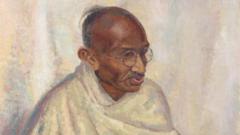Could a Rare Gandhi Oil Portrait Really Fetch Over $200,000?

A Rare Oil Portrait of Mahatma Gandhi: A Historic Auction and Its Significance
Mahatma Gandhi, a name synonymous with peace and non-violent resistance, has left an indelible mark on history. Recently, a rare oil portrait of this iconic leader was auctioned in London for an astonishing £152,800 ($204,648). This article explores the significance of the painting, its historical context, and what this auction reveals about the enduring legacy of Gandhi. The auction result far exceeded the initial estimate by Bonhams, which anticipated a price between £50,000 and £70,000. The extraordinary interest in this artwork highlights not only the value of the piece but also the reverence held for Gandhi as a pivotal figure in the fight for Indian independence.
The Artist Behind the Portrait: Clare Leighton
The portrait was painted by Clare Leighton in 1931 during Gandhi's visit to London for the Round Table Conference. Leighton, a British artist known for her strong depictions of rural life and her mastery in portraiture, had a unique opportunity. She was one of the few artists permitted to meet Gandhi, allowing her to capture his likeness authentically.
Leighton's Artistic Style
Clare Leighton's artistic style is characterized by her attention to detail and ability to convey emotion through her subjects. Her works often reflect social issues and the human condition, making her portraits not just representations but stories in themselves. Leighton's oil portrait of Gandhi is no exception; it encapsulates his serene demeanor and the profound spirit of a man who championed non-violence.
The Circumstances of the Portrait's Creation
The portrait was created during a pivotal time in Indian history. The Round Table Conference aimed to address India's demands for self-governance and constitutional reforms, making Gandhi's presence in London significant. Leighton had multiple sittings with Gandhi, providing her with the opportunity to observe and understand him beyond the surface. This intimacy is evident in the final piece, which captures Gandhi's essence as a leader.
The Historical Significance of the Portrait
This painting represents more than just a moment frozen in time; it is a testament to the struggle for independence and the power of peaceful resistance. Gandhi's philosophies have inspired numerous movements worldwide, reinforcing the importance of non-violent protest in the face of oppression.
Gandhi's Role in India's Independence Movement
Gandhi led a non-violent resistance movement against British colonial rule, advocating for civil rights, economic self-sufficiency, and social reforms. His approach not only galvanized millions of Indians but also influenced global leaders such as Martin Luther King Jr. and Nelson Mandela. The portrait, therefore, stands as an emblem of his enduring influence.
Art as a Reflection of History
Art has always served as a powerful medium for storytelling and reflection. In the case of Gandhi's portrait, it provides a visual representation of a critical historical figure during a transformative period. The significance of the painting lies not only in its artistic value but also in the story it tells about India’s struggle for freedom and the principles of peace and non-violence that Gandhi championed.
The Auction and Its Implications
The recent auction at Bonhams has sparked considerable interest, not only in the art world but also among historians and those who admire Gandhi's legacy. The final sale price far surpassed expectations, emphasizing the growing appreciation for historical artifacts that embody significant cultural and political narratives.
Market Trends in Historical Artworks
The sale of this portrait reflects broader trends in the art market, where historical pieces tied to impactful figures are becoming increasingly sought after. Collectors are recognizing the value of artworks that carry stories and historical significance, which is evident in the surprising final bid for Gandhi's portrait.
Who Purchased the Painting?
As of now, Bonhams has not disclosed the identity of the buyer, leaving art enthusiasts and historians to speculate about the future of the portrait. Will it be displayed publicly, contributing to the education of future generations about Gandhi's life and ideals? Or will it enter a private collection, possibly hidden from the public eye? The answers to these questions remain unknown, but the potential for the portrait to inspire and educate continues.
The Legacy of Mahatma Gandhi
Gandhi’s teachings of non-violence and civil disobedience have had a profound impact, extending far beyond India. His philosophy has found resonance in various movements advocating for civil rights, freedom, and social justice across the globe. The portrait serves not only as a piece of art but as a symbol of these universal ideals.
Gandhi's Influence on Modern Movements
Many contemporary leaders and activists cite Gandhi as a source of inspiration. Movements advocating for social justice, equality, and human rights often draw upon his principles. His teachings encourage individuals to resist oppression through peaceful means, making his legacy relevant in current socio-political contexts.
Commemoration of Gandhi's Legacy
Various institutions, including museums and cultural centers, work to preserve and promote the teachings and life of Gandhi. The existence of such portraits plays a pivotal role in these efforts, as they provide tangible connections to the past. They serve as reminders of the struggles faced and the victories won through perseverance and non-violence.
Conclusion
The auction of Clare Leighton’s oil portrait of Mahatma Gandhi not only highlights the value of historical art but also reinforces the enduring legacy of one of the world’s most revered leaders. As collectors and enthusiasts recognize the importance of such works, the story of Gandhi continues to inspire and educate future generations. The painting’s sale price reflects a broader appreciation for historical artifacts that carry stories of struggle, resilience, and hope.
As we reflect on this remarkable auction, we are reminded of the importance of preserving history through art and the profound impact that individuals like Gandhi have on our world. What other historical artifacts do you think deserve recognition for their cultural significance?
FAQs
What is the significance of the portrait of Gandhi sold at auction?
The portrait represents a rare artistic capture of Gandhi during a pivotal time in India's struggle for independence, emphasizing the importance of non-violence and civil disobedience.
Who painted the portrait of Mahatma Gandhi?
The painting was created by British artist Clare Leighton in 1931 during Gandhi's visit to London for the Round Table Conference.
How much was the portrait sold for at auction?
The portrait was sold for £152,800 ($204,648), significantly exceeding its estimated value of £50,000 to £70,000.
Will the portrait be displayed publicly?
It is currently unclear whether the buyer plans to display the painting publicly, as Bonhams has not disclosed the buyer's identity or intentions.
As we appreciate the value of such historical pieces, how do you think art can influence our understanding of history? #MahatmaGandhi #ArtHistory #CulturalHeritage
Published: 2025-07-16 07:34:13 | Category: world



